Enjoy this classic pork schnitzel recipe, which is wonderful German comfort food! I’m sharing all my tips and tricks for making the best pork schnitzel at home.

Schnitzel and I go way back! You see, I went to university in the Kitchener-Waterloo area of southwestern Ontario. And Kitchener-Waterloo happens to be home to the largest Oktoberfest celebration outside of Germany. So needless to say, some time was spent knee deep in the world of beer, Oktoberfest sausage and schnitzel during my time there.
I picked up a few tips for schnitzel making back then, that have served me well over the years of making schnitzel at home. And I’m going to share all the little tips and tricks with you, so you can enjoy perfect, authentic the pork schnitzel experience. So don’t be put off by my wordiness. Schnitzel is easy, I just take my schnitzel seriously :)
Why you’ll love this classic pork schnitzel recipe
- I’ve been making this schnitzel for decades and it rivals any schnitzel I’ve eaten anywhere!
- Classic pork schnitzel is perfect in its simplicity. Nothing fancy here, just pork pounded really thin, breaded in a seasoned dried breadcrumb mixture and pan fried to golden, delicious perfection.
- I’m sharing all my best tips for absolutely perfect schnitzel at home, every time!
Step-by-Step Recipe Video
Schnitzel FAQ
While pork schnitzel can be made from a variety of cuts, the easiest for home use are centre-cut boneless pork chops. Look for chops that are 1/2-3/4-inch thick. Pork loin chops usually have a thin strip of fat along one side, but no fat marble in the meat. To prepare the pork, trim any visible fat away, pound very thin and using a sharp knife, cut a couple of 1/4-inch slits evenly along that edge. This will help keep the schnitzel flat as it cooks (for even cooking), as this area may shrink up as it heats and curl, otherwise.
I always use store-bought dried breadcrumbs for schnitzel. While I use Panko for other breading, I never use it for schnitzel, because classic, authentic schnitzel is made with breadcrumbs. Fresh breadcrumbs will not work at all and I feel like homemade dried breadcrumbs are likely to be both not dry enough or not uniformly fine enough for great schnitzel.
Store-bought, plain dried breadcrumbs are what I generally use, and I season them myself with seasoning salt. Seasoned breadcrumbs will also work. As they are already seasoned, you can skip any additional seasoning. Avoid Italian seasoned breadcrumbs however, as they are seasoned with special herbs and spices best suited for Italian dishes and not schnitzel.
Thin!. Schnitzel needs to be thin. Really thin. So even if you start with thin pork loin chops, you will need to pound them even thinner. Hopefully, you have a meat pounder to do the job, if not, grab your cast-iron skillet and use it to pound the pork. Do this on a cutting board. Keep pounding until it is as thin as it can possibly be without tearing or falling apart.
I can’t stress the thin thing enough. When you cut into schnitzel, the pork shouldn’t be obviously visible. If it is, it’s a breaded pork chop, not schnitzel! The thickness of the pork should be no more than the combined thickness of the top and bottom cooked breading. That’s a schnitzel :)
The single best tip for cooking schnitzel at home is to allow the breaded pork to rest in the fridge for one hour before frying. Simply bread the pork, then lay on a cooling rack in a single layer. Place into the fridge, uncovered, for one hour before cooking. This step dries the breading and ensures it will stick perfectly to the meat during the frying process. As long as you fry in hot oil, it will come out perfectly crispy with all of its breading intact!
The absolutely best way to perfect schnitzel is to shallow-fry them in neutral-tasting cooking oil (Vegetable, Canola, Peanut, Sunflower). So you don’t need to use a lot of oil, but you want to use enough oil so that the schnitzel will “float” in the oil as it cooks and not touch the bottom of the pan. I usually aim for about 1/2-inch-ish of oil to start and I will top it up as I go, if necessary.
Heat oil over medium-high heat in a large skillet or frying pan. Test the oil by dropping a tiny speck of the schnitzel breading into the oil. If it doesn’t almost immediately sizzle and then rise to the top of the oil, your oil isn’t hot enough yet. When oil is ready, add 2 or 3 pieces of breaded pork. Do not crowd the pan and do not overlap them. They need to lay flat with a nice bit of space between. You will probably need to cook in batches.
Using tongs, check the browning of the underside regularly and lower/raise the temperature if it seems to be browning too quickly or slowly. It should take about 3 minutes to brown the underside.
Cook until the underside is very golden brown, then flip and cook the other side until golden. Remove to a cooling rack with a sheet of paper towel underneath it to catch any drips. (If making a lot of batches, you can also place on a baking sheet and keep warm in a 200F oven)
Recipe Tips
- If you’re cooking many batches of schnitzel, you may need to top up the oil level after a few batches. Allow it to re-heat thoroughly again before proceeding. If cooking a lot of schnitzel, it’s probably worthwhile to replace all the oil and reheat it part way through, as it will start to get “dirty” and affect the finished quality of the schnitzel.
- Don’t fear the shallow frying, but do shallow fry safely. Use a deep, heavy-bottom pan/skillet. Keep a lid (or a baking sheet large enough to cover the entire top of the pan) handy. In the very unlikely event that the oil ignites, you can immediately extinguish it by placing the lid on top. Keep kids out of the kitchen when hot oil is happening on the stove.
- Don’t be tempted to deep fry schnitzel. Schnitzel should not be that crispy and it’s way more work than is necessary.
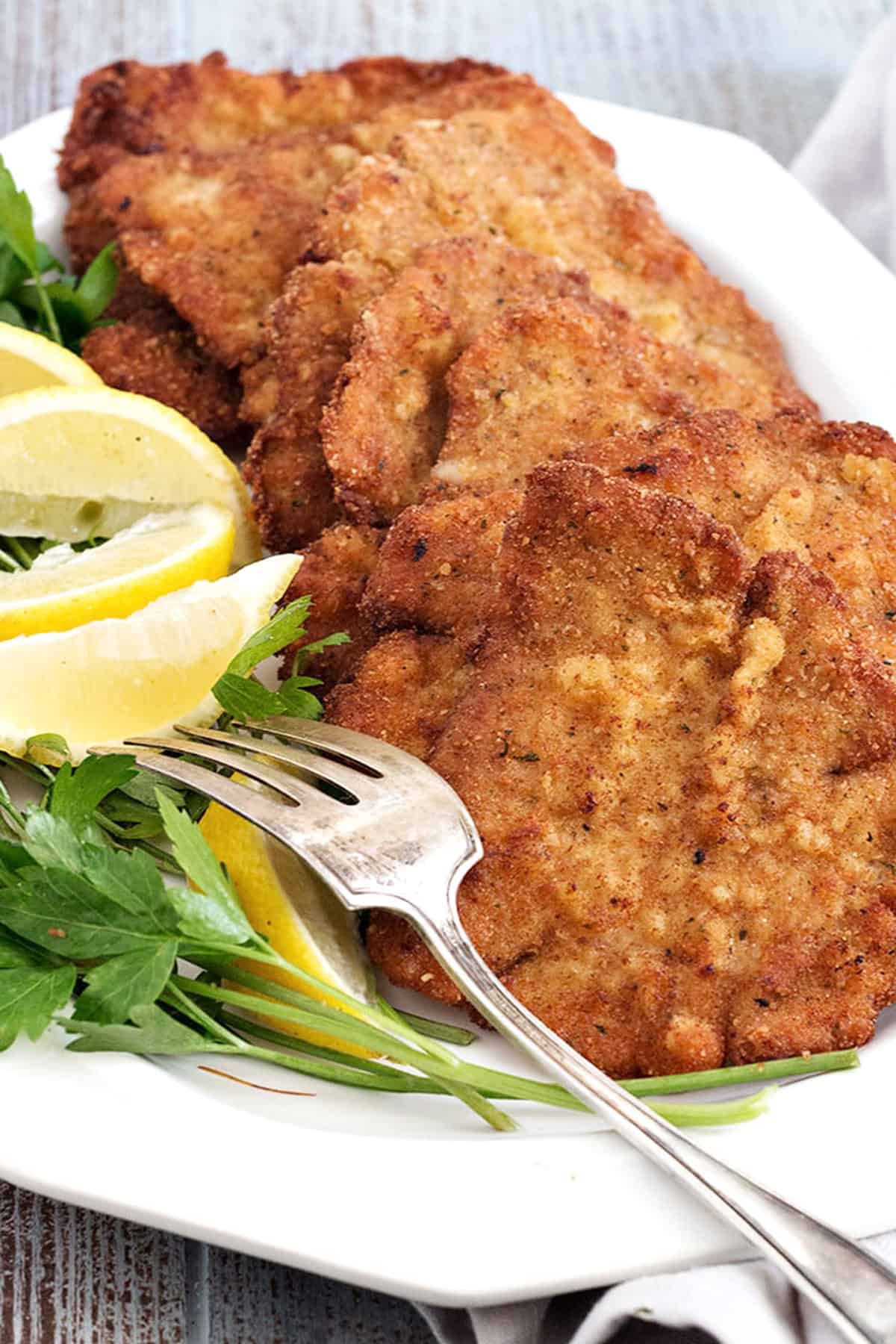
What to serve with pork schnitzel?
Traditionally, schnitzel is served with potatoes – either potato salad, fried potatoes or sometimes boiled potatoes. I think mashed potatoes are a fine side, as well. Add a salad or a veg to round it out, if you like.
As for what to put on your schnitzel, there are a number of options. A simple squeeze of lemon from lemon wedges is the perfect foil for the fried schnitzel. A mushroom gravy makes it a Hunter’s Schnitzel. A local restaurant with an Austrian chef who makes the most fabulous schnitzel serves his with Lingonberry sauce and it’s absolutely delicious. You may recognize that name from the Swedish jam that you can buy at Ikea. The Ikea jam might do nicely with schnitzel or I think a cranberry sauce would be a similar flavour profile and easier to make at home.
Want to save this recipe?
Enter your email and I’ll send it to your inbox. Plus, you’ll get great new recipes from me every week!
By submitting this form, you consent to receive emails from Seasons and Suppers.
You can unsubscribe at any time.
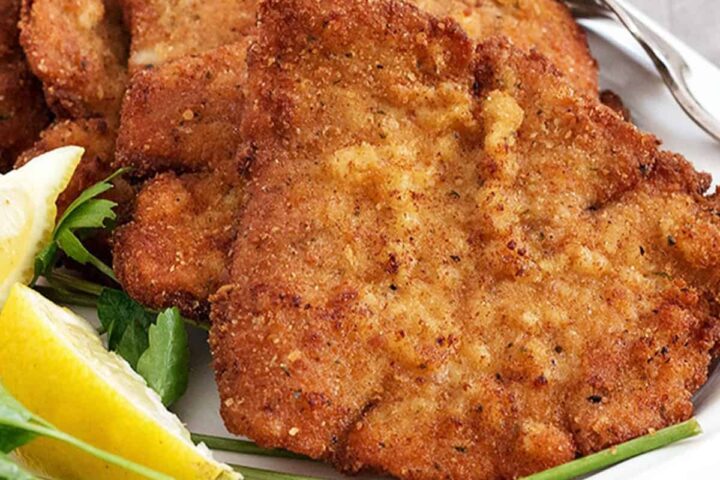
Get the Recipe: Classic Pork Schnitzel
Ingredients
- 6 boneless, centre-cut pork loin chops
Breading:
- 1/2 cup all-purpose flour, unbleached recommended
- Salt and freshly ground pepper, just use a bit if using seasoned bread crumbs
- 2 large eggs
- 2 Tablespoons water
- 2 cups dried plain or seasoned breadcrumbs, plus more as needed.
- 1/2 – 1 teaspoons seasoning salt, omit if using seasoned bread crumbs
- Vegetable, canola, peanut or sunflower oil, for shallow frying.
- Lemon slices, for serving
Instructions
- Trim the pork of any fat along the edge and using the tip of a knife, cut about three 1/4-inch slits along the edge where you trimmed the fat. Pound each piece of pork with a meat pounder/hammer until it is VERY thin – almost, but not quite to the point that it will tear and fall apart. Using the tip of a sharp knife, cut small nicks every 2-inches around the outside edge. Set aside.
- Set up a breading station with 3 shallow plates (large enough to lay a piece of your pork flat). Add the flour to the first plate, spreading it into an even layer. Season with some salt and freshly ground pepper. On the second plate, use a fork to whisk together the eggs and water. Scatter the breadcrumbs on the 3rd plate and add the seasoning salt. Stir to mix in well. To bread your pork: first press the pork into the flour, flouring both sides and shaking off any excess. Next lay the floured pork into the egg mixture and swirl it around a bit. Flip over and do the same on the other side. Lift and let excess egg drip off back onto the plate. Finally, lay the pork onto the plate with the breadcrumbs. Use your fingers or a spoon to move some of the breadcrumbs onto the top of the pork. Press down gently so that the underside gets nicely coated in crumbs, then flip over and press down again. Make sure you have an even layer of crumbs covering the entire piece of pork on both sides. If there are bare spots, sprinkle breadcrumbs over that area and press down onto the meat with the palm of your hand.
- Place the breaded pork onto a cooking rack set on top of a baking sheet. Repeat with each piece of pork, placing onto the cooling rack without overlapping at all. Place the baking sheet/cooling rack with the breaded pork into the fridge, UNCOVERED, for one hour.
- When it has been almost an hour, start heating your oil. Add oil to a heavy-bottomed, high-sided skillet to about 1/4-inch (or about 1/2 the height of your breaded pork). Heat oil over medium-high heat until hot. Test by taking a few crumbs from the pork and dropping them into the oil. They should immediately sizzle and quickly float to the top.
- Add 1-2 pieces of pork to the hot oil. Don't crowd the pan or overlap them. The schnitzel should lay flat and have a nice bit of space between. Allow to cook for about a minute, then use tongs to regularly check the progress of browning on the underside. You may need to adjust your heat down if they seem to be browning too quickly or up a notch if they aren't browning quickly enough. It should take about 3 minutes per side with the right temperature of oil and the proper thinness of the schnitzel. Once the underside is a deep golden brown, flip and brown the other side. Remove to a cooling rack with a piece of paper towel under it to catch drops (not directly under the meat, under the cooling rack). Repeat with remaining pork pieces. *If making lots and you want to keep them warm, place on a baking sheet in a 200F oven to keep warm and crispy.
- Serve with lemon slices or try lingonberry jam (my favourite!).
Notes
More Pork Recipes to Love!
Hi! I’m Jennifer, a home cook schooled by trial and error and almost 40 years of getting dinner on the table! I love to share my favourite recipes, both old and new, together with lots of tips and tricks to hopefully help make your home cooking enjoyable, stress free, rewarding and of course, delicious!


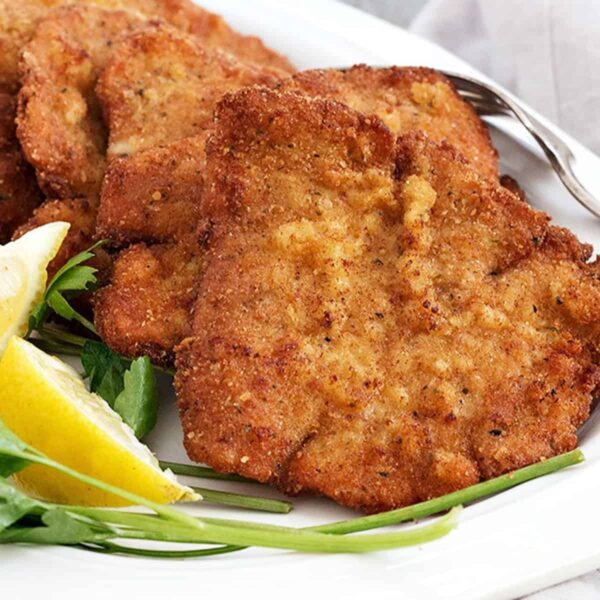
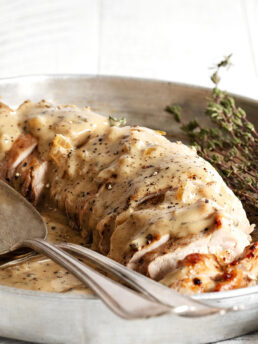
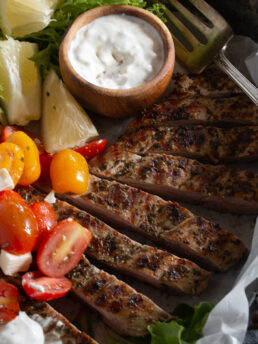
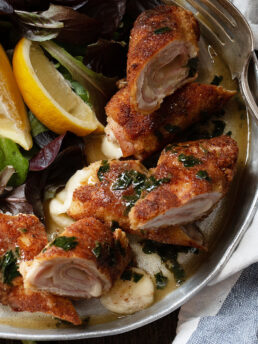

Patricia – July, 2024 –
I have made this in the past and found the bottom almost burnt..now in re-reading today, I realize I did not use enough oil to “float” the schnitzel. My bad…
Excellent recipe. I want to cook & freeze these, and recrisp in the air fryer 🙂
So glad you are enjoying them Patricia and yes, freezing ahead is always a great idea! Thanks :)
I am making about 20 right now, trying to decide… Freeze them raw? Or cook then freeze when cooled and drained?
Ideas?
Hi Pat, I have never tried freezing them uncooked, so I can’t give you a definitive answer. I generally freeze them cooked which works out pretty well (reheating in the oven).
We loved this dish. Served it with mashed potatoes and homemade onion gravy.
So pleased you enjoyed it, Lori :) Thanks so much!
Other than creating a lot dishes, this Schnitzel was perfect. Was going to make a mushroom gravy but my mushrooms were beyond usable. Did have lemons and lingonberry jam.
My green beans had to be trashed so used frozen peas.
So glad you enjoyed it! Thanks :)
Best Schnitzel ever! Followed recipe exactly and my family were amazed. No need to ever use a different schnitzel recipe. Thank you!
So glad to hear, Kristine :) Thanks so much!
I’ve been working with a theatre company doing the Sound of Music and after listening to the songs every day I just have to make Schnitzel with noodles (spaetle actually) – “Doorbells and sleigh bells and schnitzel with noodles”. I should probably make crisp apple strudel too but thats too much work! Thanks for the recipe. Just noticing though that you discourage the use of garlic though it is a predominant ingredient in seasoning salt.
Thanks Shelly :) While there is a bit of garlic is seasoned salt, there is not enough to make it a dominant flavour, generally. I really just wanted to suggest that classic schnitzel should not be garlic-y, in case anyone was thinking of adding garlic salt or powder to the mix.
I made this last night and followed the recipe exactly. It was so tender and delicious. This will now be my go to recipe for pork. Thank you so much.
So glad you enjoyed it, Nikki :) It’s a favourite here, too. Thanks so much!
Hi Jennifer…..Can the schnitzel be air-fried?…..Gigi
Hi Gigi, technically, you can put just about anything into an air-fryer, but if you want to enjoy a good and proper schnitzel, it really needs to be shallow fried in oil, as detailed. An air-fried schnitzel would be lacking in both flavour and texture.
can I make schnitzel and refrigerate it to cook the next day?
Hi Ruth, I have never tried it, but I feel like it’s probably not ideal. Can I ask why you want to do it this way? You can “make it ahead” somewhat on the same day, as it needs to be refrigerated for 1 hour before cooking (which you could easily stretch out a bit more, if needed). I think if I really needed to make ahead a longer time ahead, I’d probably cook it, refrigerate and then “re-crisp” in the oven to serve.
Best homemade schnitzel ever! i did use homemade crumbs but I toasted them first and seasoned them with seasoning salt like you suggested. We used to get schnitzel at The Marienbad or The Budapest Restaurants in London, ON. It has been a few years since we have been able to get to either restaurant, so thank you so much for providing such an amazing recipe!
So glad you enjoyed it, Elizabeth :) Thanks so much!